Haipeng Zhang
Tiered Agentic Oversight: A Hierarchical Multi-Agent System for AI Safety in Healthcare
Jun 14, 2025Abstract:Current large language models (LLMs), despite their power, can introduce safety risks in clinical settings due to limitations such as poor error detection and single point of failure. To address this, we propose Tiered Agentic Oversight (TAO), a hierarchical multi-agent framework that enhances AI safety through layered, automated supervision. Inspired by clinical hierarchies (e.g., nurse, physician, specialist), TAO conducts agent routing based on task complexity and agent roles. Leveraging automated inter- and intra-tier collaboration and role-playing, TAO creates a robust safety framework. Ablation studies reveal that TAO's superior performance is driven by its adaptive tiered architecture, which improves safety by over 3.2% compared to static single-tier configurations; the critical role of its lower tiers, particularly tier 1, whose removal most significantly impacts safety; and the strategic assignment of more advanced LLM to these initial tiers, which boosts performance by over 2% compared to less optimal allocations while achieving near-peak safety efficiently. These mechanisms enable TAO to outperform single-agent and multi-agent frameworks in 4 out of 5 healthcare safety benchmarks, showing up to an 8.2% improvement over the next-best methods in these evaluations. Finally, we validate TAO via an auxiliary clinician-in-the-loop study where integrating expert feedback improved TAO's accuracy in medical triage from 40% to 60%.
Code Graph Model (CGM): A Graph-Integrated Large Language Model for Repository-Level Software Engineering Tasks
May 22, 2025Abstract:Recent advances in Large Language Models (LLMs) have shown promise in function-level code generation, yet repository-level software engineering tasks remain challenging. Current solutions predominantly rely on proprietary LLM agents, which introduce unpredictability and limit accessibility, raising concerns about data privacy and model customization. This paper investigates whether open-source LLMs can effectively address repository-level tasks without requiring agent-based approaches. We demonstrate this is possible by enabling LLMs to comprehend functions and files within codebases through their semantic information and structural dependencies. To this end, we introduce Code Graph Models (CGMs), which integrate repository code graph structures into the LLM's attention mechanism and map node attributes to the LLM's input space using a specialized adapter. When combined with an agentless graph RAG framework, our approach achieves a 43.00% resolution rate on the SWE-bench Lite benchmark using the open-source Qwen2.5-72B model. This performance ranks first among open weight models, second among methods with open-source systems, and eighth overall, surpassing the previous best open-source model-based method by 12.33%.
Picturized and Recited with Dialects: A Multimodal Chinese Representation Framework for Sentiment Analysis of Classical Chinese Poetry
May 19, 2025Abstract:Classical Chinese poetry is a vital and enduring part of Chinese literature, conveying profound emotional resonance. Existing studies analyze sentiment based on textual meanings, overlooking the unique rhythmic and visual features inherent in poetry,especially since it is often recited and accompanied by Chinese paintings. In this work, we propose a dialect-enhanced multimodal framework for classical Chinese poetry sentiment analysis. We extract sentence-level audio features from the poetry and incorporate audio from multiple dialects,which may retain regional ancient Chinese phonetic features, enriching the phonetic representation. Additionally, we generate sentence-level visual features, and the multimodal features are fused with textual features enhanced by LLM translation through multimodal contrastive representation learning. Our framework outperforms state-of-the-art methods on two public datasets, achieving at least 2.51% improvement in accuracy and 1.63% in macro F1. We open-source the code to facilitate research in this area and provide insights for general multimodal Chinese representation.
Embedding Radiomics into Vision Transformers for Multimodal Medical Image Classification
Apr 15, 2025Abstract:Background: Deep learning has significantly advanced medical image analysis, with Vision Transformers (ViTs) offering a powerful alternative to convolutional models by modeling long-range dependencies through self-attention. However, ViTs are inherently data-intensive and lack domain-specific inductive biases, limiting their applicability in medical imaging. In contrast, radiomics provides interpretable, handcrafted descriptors of tissue heterogeneity but suffers from limited scalability and integration into end-to-end learning frameworks. In this work, we propose the Radiomics-Embedded Vision Transformer (RE-ViT) that combines radiomic features with data-driven visual embeddings within a ViT backbone. Purpose: To develop a hybrid RE-ViT framework that integrates radiomics and patch-wise ViT embeddings through early fusion, enhancing robustness and performance in medical image classification. Methods: Following the standard ViT pipeline, images were divided into patches. For each patch, handcrafted radiomic features were extracted and fused with linearly projected pixel embeddings. The fused representations were normalized, positionally encoded, and passed to the ViT encoder. A learnable [CLS] token aggregated patch-level information for classification. We evaluated RE-ViT on three public datasets (including BUSI, ChestXray2017, and Retinal OCT) using accuracy, macro AUC, sensitivity, and specificity. RE-ViT was benchmarked against CNN-based (VGG-16, ResNet) and hybrid (TransMed) models. Results: RE-ViT achieved state-of-the-art results: on BUSI, AUC=0.950+/-0.011; on ChestXray2017, AUC=0.989+/-0.004; on Retinal OCT, AUC=0.986+/-0.001, which outperforms other comparison models. Conclusions: The RE-ViT framework effectively integrates radiomics with ViT architectures, demonstrating improved performance and generalizability across multimodal medical image classification tasks.
Influence Maximization in Temporal Social Networks with a Cold-Start Problem: A Supervised Approach
Apr 15, 2025Abstract:Influence Maximization (IM) in temporal graphs focuses on identifying influential "seeds" that are pivotal for maximizing network expansion. We advocate defining these seeds through Influence Propagation Paths (IPPs), which is essential for scaling up the network. Our focus lies in efficiently labeling IPPs and accurately predicting these seeds, while addressing the often-overlooked cold-start issue prevalent in temporal networks. Our strategy introduces a motif-based labeling method and a tensorized Temporal Graph Network (TGN) tailored for multi-relational temporal graphs, bolstering prediction accuracy and computational efficiency. Moreover, we augment cold-start nodes with new neighbors from historical data sharing similar IPPs. The recommendation system within an online team-based gaming environment presents subtle impact on the social network, forming multi-relational (i.e., weak and strong) temporal graphs for our empirical IM study. We conduct offline experiments to assess prediction accuracy and model training efficiency, complemented by online A/B testing to validate practical network growth and the effectiveness in addressing the cold-start issue.
Relating the Seemingly Unrelated: Principled Understanding of Generalization for Generative Models in Arithmetic Reasoning Tasks
Jul 25, 2024
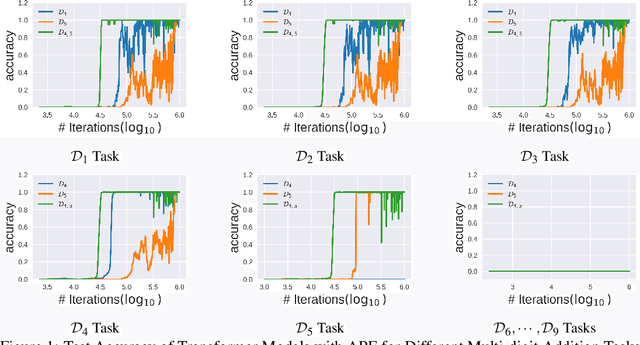
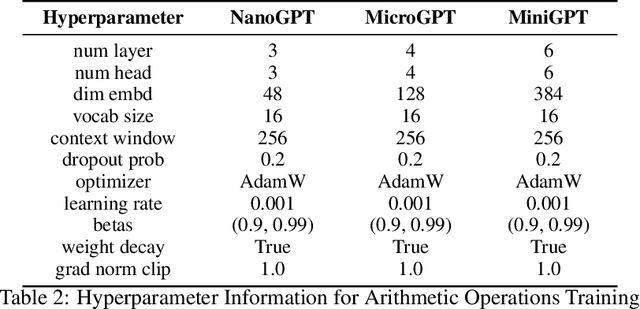

Abstract:Large language models (LLMs) have demonstrated impressive versatility across numerous tasks, yet their generalization capabilities remain poorly understood. To investigate these behaviors, arithmetic tasks serve as important venues. In previous studies, seemingly unrelated mysteries still exist -- (1) models with appropriate positional embeddings can correctly perform longer unseen arithmetic operations such as addition, but their effectiveness varies in more complex tasks like multiplication; (2) models perform well for longer unseen cases in modular addition under specific moduli (e.g., modulo 100) but struggle under very close moduli (e.g., modulo 101), regardless of the positional encoding used. We believe previous studies have been treating the symptoms rather than addressing the root cause -- they have paid excessive attention to improving model components, while overlooking the differences in task properties that may be the real drivers. This is confirmed by our unified theoretical framework for different arithmetic scenarios. For example, unlike multiplication, the digital addition task has the property of translation invariance which naturally aligns with the relative positional encoding, and this combination leads to successful generalization of addition to unseen longer domains. The discrepancy in operations modulo 100 and 101 arises from the base. Modulo 100, unlike 101, is compatible with the decimal system (base 10), such that unseen information in digits beyond the units digit and the tens digit is actually not needed for the task. Extensive experiments with GPT-like models validate our theoretical predictions. These findings deepen our understanding of the generalization mechanisms, and facilitate more data-efficient model training and objective-oriented AI alignment.
DUPLEX: Dual GAT for Complex Embedding of Directed Graphs
Jun 08, 2024
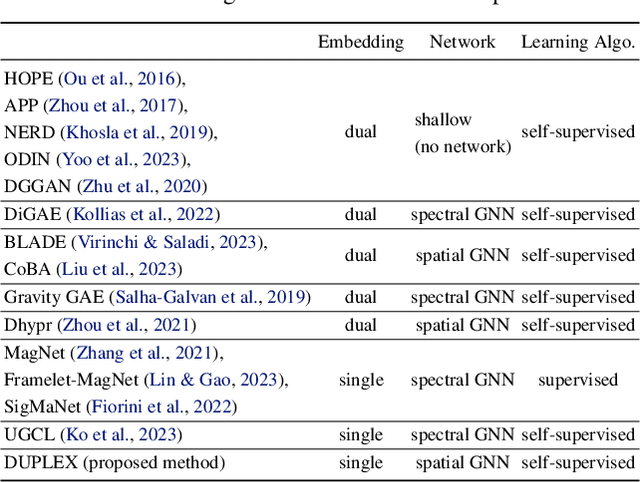

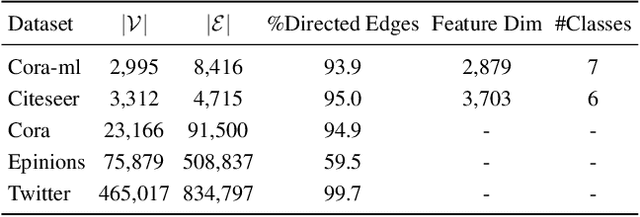
Abstract:Current directed graph embedding methods build upon undirected techniques but often inadequately capture directed edge information, leading to challenges such as: (1) Suboptimal representations for nodes with low in/out-degrees, due to the insufficient neighbor interactions; (2) Limited inductive ability for representing new nodes post-training; (3) Narrow generalizability, as training is overly coupled with specific tasks. In response, we propose DUPLEX, an inductive framework for complex embeddings of directed graphs. It (1) leverages Hermitian adjacency matrix decomposition for comprehensive neighbor integration, (2) employs a dual GAT encoder for directional neighbor modeling, and (3) features two parameter-free decoders to decouple training from particular tasks. DUPLEX outperforms state-of-the-art models, especially for nodes with sparse connectivity, and demonstrates robust inductive capability and adaptability across various tasks. The code is available at https://github.com/alipay/DUPLEX.
Mitigate Position Bias with Coupled Ranking Bias on CTR Prediction
May 29, 2024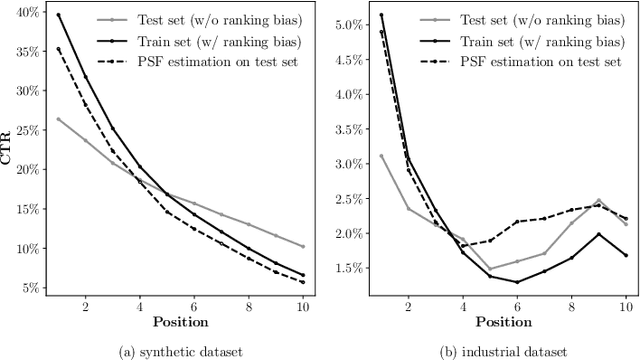


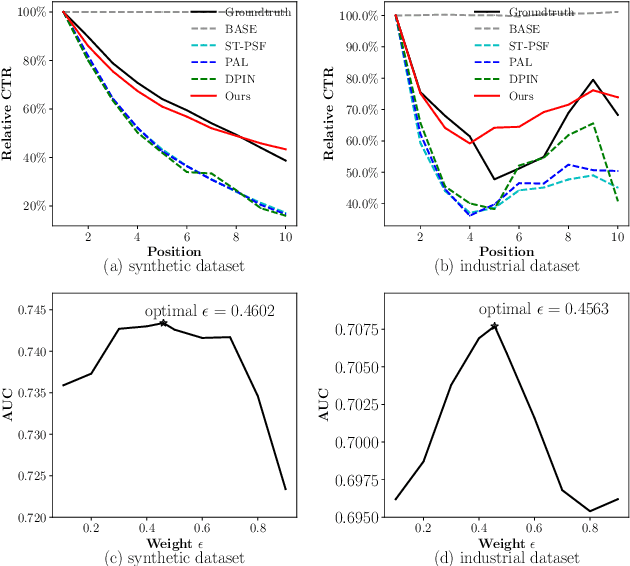
Abstract:Position bias, i.e., users' preference of an item is affected by its placing position, is well studied in the recommender system literature. However, most existing methods ignore the widely coupled ranking bias, which is also related to the placing position of the item. Using both synthetic and industrial datasets, we first show how this widely coexisted ranking bias deteriorates the performance of the existing position bias estimation methods. To mitigate the position bias with the presence of the ranking bias, we propose a novel position bias estimation method, namely gradient interpolation, which fuses two estimation methods using a fusing weight. We further propose an adaptive method to automatically determine the optimal fusing weight. Extensive experiments on both synthetic and industrial datasets demonstrate the superior performance of the proposed methods.
Paths of A Million People: Extracting Life Trajectories from Wikipedia
May 25, 2024



Abstract:Notable people's life trajectories have been a focus of study -- the locations and times of various activities, such as birth, death, education, marriage, competition, work, delivering a speech, making a scientific discovery, finishing a masterpiece, and fighting a battle, and how these people interact with others, carry important messages for the broad research related to human dynamics. However, the scarcity of trajectory data in terms of volume, density, and inter-person interactions, limits relevant studies from being comprehensive and interactive. We mine millions of biography pages from Wikipedia and tackle the generalization problem stemming from the variety and heterogeneity of the trajectory descriptions. Our ensemble model COSMOS, which combines the idea of semi-supervised learning and contrastive learning, achieves an F1 score of 85.95%. For this task, we also create a hand-curated dataset, WikiLifeTrajectory, consisting of 8,852 (person, time, location) triplets as ground truth. Besides, we perform an empirical analysis on the trajectories of 8,272 historians to demonstrate the validity of the extracted results. To facilitate the research on trajectory extractions and help the analytical studies to construct grand narratives, we make our code, the million-level extracted trajectories, and the WikiLifeTrajectory dataset publicly available.
For the Misgendered Chinese in Gender Bias Research: Multi-Task Learning with Knowledge Distillation for Pinyin Name-Gender Prediction
May 10, 2024



Abstract:Achieving gender equality is a pivotal factor in realizing the UN's Global Goals for Sustainable Development. Gender bias studies work towards this and rely on name-based gender inference tools to assign individual gender labels when gender information is unavailable. However, these tools often inaccurately predict gender for Chinese Pinyin names, leading to potential bias in such studies. With the growing participation of Chinese in international activities, this situation is becoming more severe. Specifically, current tools focus on pronunciation (Pinyin) information, neglecting the fact that the latent connections between Pinyin and Chinese characters (Hanzi) behind convey critical information. As a first effort, we formulate the Pinyin name-gender guessing problem and design a Multi-Task Learning Network assisted by Knowledge Distillation that enables the Pinyin embeddings in the model to possess semantic features of Chinese characters and to learn gender information from Chinese character names. Our open-sourced method surpasses commercial name-gender guessing tools by 9.70\% to 20.08\% relatively, and also outperforms the state-of-the-art algorithms.
 Add to Chrome
Add to Chrome Add to Firefox
Add to Firefox Add to Edge
Add to Edge